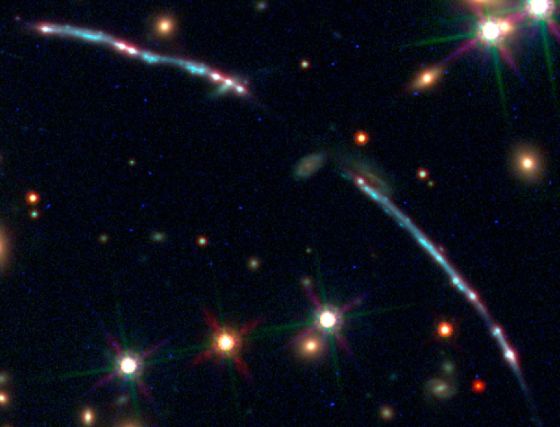Background
The finite speed of light enables us to look back in time as we peer out in the universe. This enables us to study how galaxies were formed and how they evolved throughout the history of the universe. However, it is difficult to study distant galaxies in detail: Each galaxy only covers a few pixels, even in the best images from the Hubble Space Telescope, and they are so faint that they are only barely detected even with our largest telescopes. Nature has provided us with a tool to overcome these obstacles: Light rays from distant galaxies are deflected in the gravitational field of a massive object, such as a cluster of galaxies, which acts as a lens. This phenomenon is known as gravitational lensing. If the distant galaxy and the lens are almost perfectly aligned along our line of sight, the light will be focused towards us and the distant source will be magnified. This enables us to see objects and study phenomena which would otherwise be unobservable.
About the project
By studying a newly discovered galaxy which has been magnified more than 50 times by a gravitational lens, this project will map in detail how stars and galaxies are distributed and reveal how star formation occurred in a galaxy seen when the universe was only 25 percent of its present age.
Furthermore, the project will determine the mass of a supermassive black hole in the centre of a galaxy, looking 11 billion years back in time. A black hole has never been weighed before at such a large distance. The energy emitted from the immediate surroundings of such supermassive black holes play a crucial role in regulating star formation in galaxies. Hence, the black hole mass determination will be used to discriminate between different models of the co-evolution of supermassive black holes and their surrounding galaxies.
Finally, the project is using the Nordic Optical Telescope to search for new powerful gravitational lenses among the galaxy clusters recently discovered by the ESA Planck mission.
Objectives
The primary objective of the proposal is to exploit the magnification effect of gravitational lensing to probe galaxy evolution in unprecedented detail: Specifically, the project seeks to map the gas and stellar mass content and star formation activity in the brightest gravitationally lensed galaxy in the Universe, down to the scales of individual molecular clouds. In addition, the project aims to determine whether supermassive black holes have co-evolved with their host galaxies over the past >11 Gyr.
A secondary objective is making a mass measurement of a supermassive black hole in a distant gravitationally lensed quasar.
Another secondary objective is to conduct a survey of newly discovered galaxy clusters using the Nordic Optical Telescope in order to establish a list of gravitational lenses best suited for future studies of the earliest galaxies using the James Webb Space Telescope.
Outcomes
An analysis of spectroscopic observations obtained during summer 2017 with the Magellan telescope in Chile show that the brightest gravitationally lensed galaxy has properties that have been theoretically predicted, but never previously observed: The observed spectrum shows that emission from the Lyman-alpha line (representing transitions between the ground state and first excited state in the hydrogen atom) is largely escaping unhindered from the brightest portions of the galaxy (Rivera-Thorsen et al. 2017). This also makes escape of even more energetic, ionizing photons highly plausible. Such escape of ionizing radiation has so far only been measured in a handful of galaxies at this distance, none of them as highly magnified as this galaxy. This presents a first opportunity for a detailed study of how the ionizing photons, which reionised the universe 400 million years after the Big bang, escaped from star-forming galaxies in the early universe. During 2018 we have made follow-up observations with the Hubble Space Telescope to directly detect the ionising radiation escaping from this galaxy. The ionising radiation is only seen to escape from a compact, localised region within the galaxy. This region is characterised by a high star formation rate, containing very young stars (with ages less than 3 million years) and low abundances of elements heavier than hydrogen and helium. As a result of the gravitational lensing effect, we are able to see 12 distinct images of the same region. The Hubble Space Telescope data show significant variations in the ration between the measured fluxes at to separate wavelengths (275 nanometers and 814 nanometers). These variations are caused by variations in the absorption by neutral hydrogen gas along spatially separated lines of sight. This has enabled us to demonstrate corresponding variations in the distribution of intergalactic hydrogen gas on spatial scales less than 1 kiloparsec, a hundred times smaller than the smallest scales that have been previously probed this way.
These results have been published in a recent Science paper.
Background
The projects uses space-based data from the Hubble Space Telescope, the Spitzer Space Telescope and the Chandra X-ray telescope in addition to ground-based data from the Magellan telescopes, the Nordic Optical Telescope and the Gemini Telescope.
The main international collaborators for the proposed project are as follows:
- Dr. J. Rigby (NASA Goddard Space Flight Center) is Deputy Project Scientist for Operations for JWST. She contributes her expertise using spectroscopic studies of star-forming galaxies at intermediate and high redshifts to reveal their physical properties.
- Prof. K. Sharon (U. Michigan) contributes expertise on strong lens mass modelling, producing precise magnification maps for cluster lenses which are required to convert observed properties into the intrinsic (unlensed) physical properties of the gravitationally lensed galaxies.
- Dr. M. Gronke (UC Santa Barbara) contributes expertise on interpreting observed spectra of the Ly-α emission line in distant galaxies in terms of their physical conditions and morphology of dust and gas.
- Prof. T. Treu (UCLA) contributes expertise on gravitational lensing of quasars, reverberation mapping, and the role of supermassive black holes for galaxy evolution and high-redshift galaxies.
- Prof. M. Gladders (U. Chicago) contributes expertise on observational studies of galaxy clusters and strong gravitational lensing.
Financing
The project is funded by the Research Council of Norway through the ROMFORSK program.

